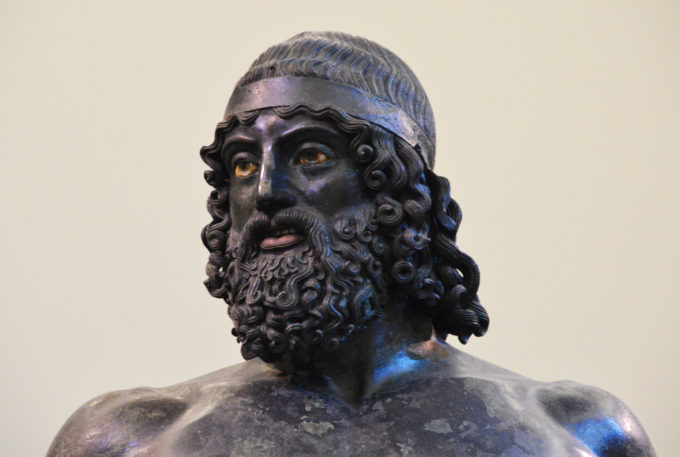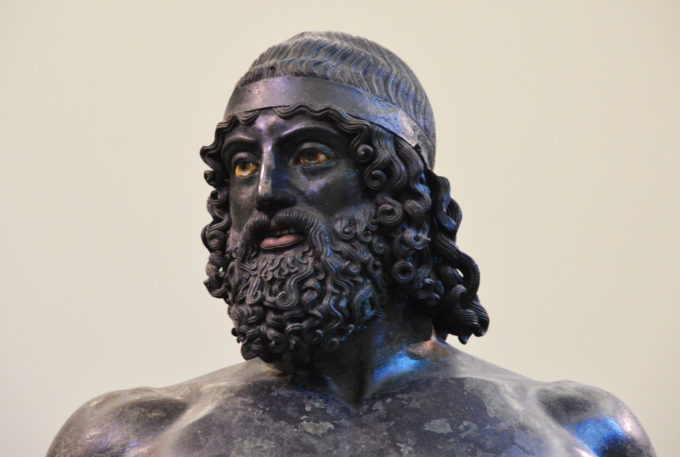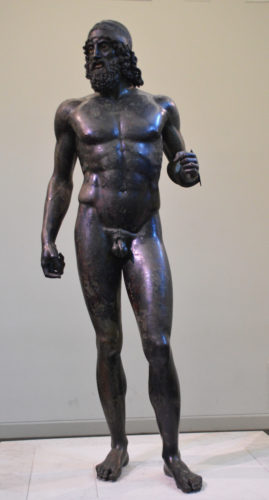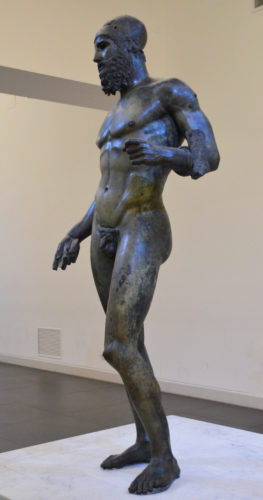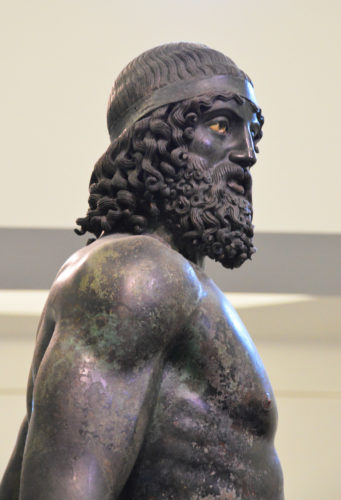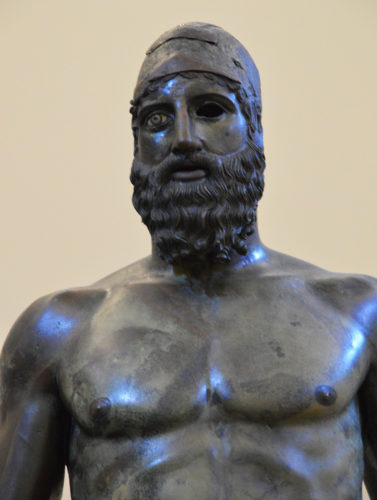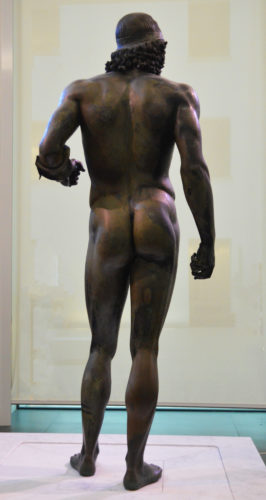THE RIACE BRONZES
One of the highlights of an exciting road trip through southern Italy was a visit to Reggio Calabria (the toe of the boot) to see the Riace Bronzes at Museo Archeologico Nazionale di Reggio Calabria. They are truly a magnificent example of physical perfection! These bronze masterpieces laid at the bottom of the Mediterranean Sea for an estimated 2000 years. On August 16th, 1972, a recreational scuba diver, Stefano Mariottini, discovered the Riace Bronzes in the Ionian Sea, off the coast of Riace, Italy.
Artists skillfully worked to beautifully bring the statues back to their former glory. After about two years of restoration, they revealed the marvelous skill and craftsmanship that went into making them. These statues are displayed in a controlled environment at the museum. Every person who enters the viewing room must first enter an airlock. Viewers must pass through a high-tech cleansing process before entering the room to see the great statues. It’s quite an interesting process but once you actually get close to these well-respected works of art, you’ll appreciate all the precautions taken.
The Riace Bronzes (or Warriors) are referred to as Statue A and Statue B; they are 6 1/2 and almost 6 3/4 feet tall, respectively. These two breathtakingly impressive Bronzes are mesmerizing. How amazing to think that these statues were crafted by Greek sculptors 2,500 years ago!
Yes, 2500 years ago! Experts estimate that statue A dates back to around 460 to 450 BC and Statue B, between 430 and 420 BC.
What impressed me most, aside from the obvious physical perfection, is the attention to detail of their hair and beards on these statues, especially Statue A.
The time taken to carve each lock of hair shows the dedication that these artists had for their craft. This task is extremely time-consuming, especially considering it was done so very long ago. It’s absolutely fascinating to see.
Copper was used to making their lips and nipples, silver was cast for their teeth and their eyes were probably made of either ivory or glass and set in pronged settings as in jewelry. Absolutely fascinating!
Even though he’s missing one eye, you can see how perfectly the eye socket was crafted to hold the glass eye.
I studied Sculpture in college while pursuing a degree in Mathematics, so I appreciate the workmanship that it takes to sculpt bronzes of this magnitude.
We used the lost wax process at my college. The students would sculpt a statue in wax first. We had to add a “funnel” to the top of the wax piece where we would pour the molten bronze. We attached “vents” (thin wax tubes) at all the low points so that the air could escape. This way, there weren’t any air pockets or empty spaces in the final product.
Already you can see the amount of care and attention to detail that goes into a work of art like this. We would create a mold using plaster of Paris. The plaster molds were baked in a kiln where the wax would evaporate, essentially lost. That mold was cast, in our foundry, by carefully pouring hot, liquid bronze into the “funnel”, then left to cool completely.
At this point, we would chip away at the plaster mold, destroying it, to uncover the bronze statue. The vents and funnel were sawed off and the piece was sanded and polished to finish. This is an incredibly labor-intensive process but it creates captivating works of bronze artwork that will last for ages are created.
The process used to create the breathtaking lifelike Riace bronzes was a little different but just as much a labor of love. Statues of this magnitude were hollow (like a chocolate Easter bunny) and usually sculpted on a clay-based sculpture. Rods added support to the structure. The artist applied wax to the base sculpture and carved out the very fine details. Then, he carefully covered the base with another layer of clay or plaster to retain the detail. The wax had to be melted away (lost) and the molten bronze would fill in the area between the two pieces of clay.
The sculptor had to make the statues in sections, then put the bronze pieces together. The process is quite laborious even with modern technology; I am in awe of the artists who were able to create such magnificent works of bronze art. How fortunate we are that they have passed along their techniques and knowledge! I am so grateful to have had the opportunity to visit the Warriors!
I highly suggest visiting the Museo Archeologico Nazionale di Reggio Calabria even if just to see the Riace Bronzes. If you are a sculptor and/or have ever worked with bronze, you definitely won’t want to miss this opportunity to get up close to such ancient life-like bronze artwork with enormous attention to details.
JMS

